Two events yesterday morning made yet another threat of barbed wire for wildlife painfully clear.
I apologize for three sequential posts on the same species but Burrowing Owls have been my primary subject of late and I like to post current images when I can. Besides, I thought this post needed to be timely.
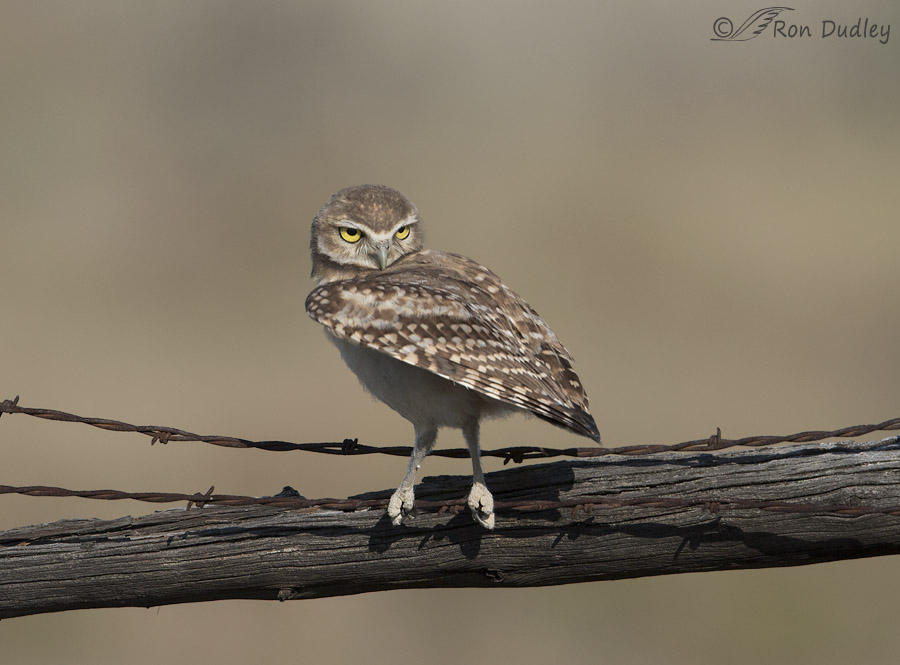
1/3200, f/6.3, ISO 500, Canon 7D Mark II, Canon EF500mm f/4L IS II USM +1.4 tc, not baited, set up or called in
Once again I spent part of the morning in Box Elder County photographing Burrowing Owls. This juvenile (it seems to have an unusual small white growth on its lower left leg) was perched on an old, rusty strand of barbed wire stretched in front of a horizontal fence rail when it decided to take off. As I’ve said before they typically launch in the direction their body is facing but that’s unpredictable and this one looked back and then…
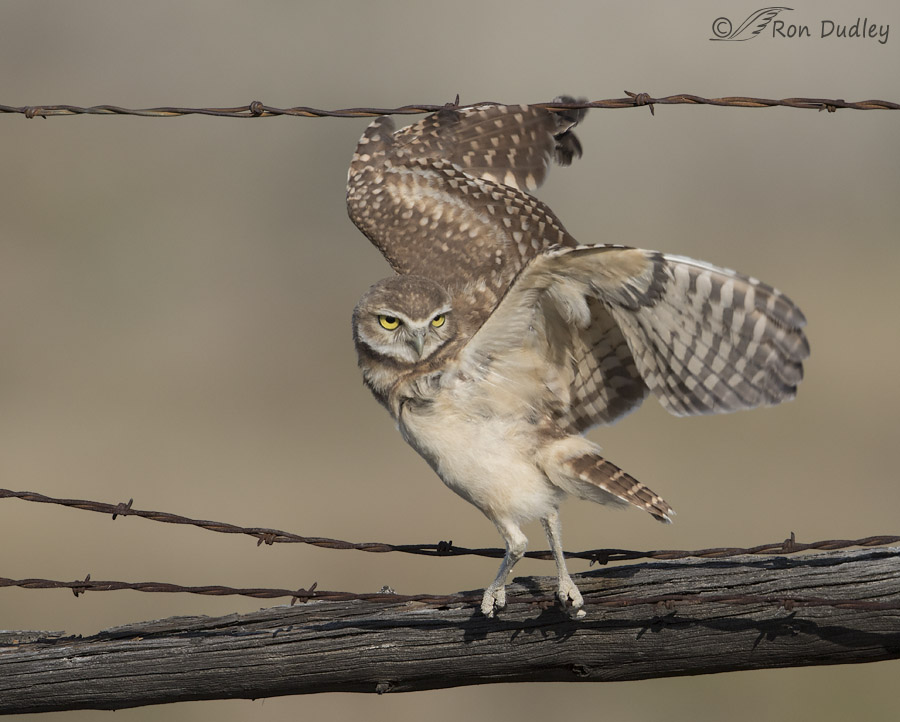
1/3200, f/6.3, ISO 500, Canon 7D Mark II, Canon EF500mm f/4L IS II USM +1.4 tc, not baited, set up or called in
twisted on its perch to take off almost directly toward me.
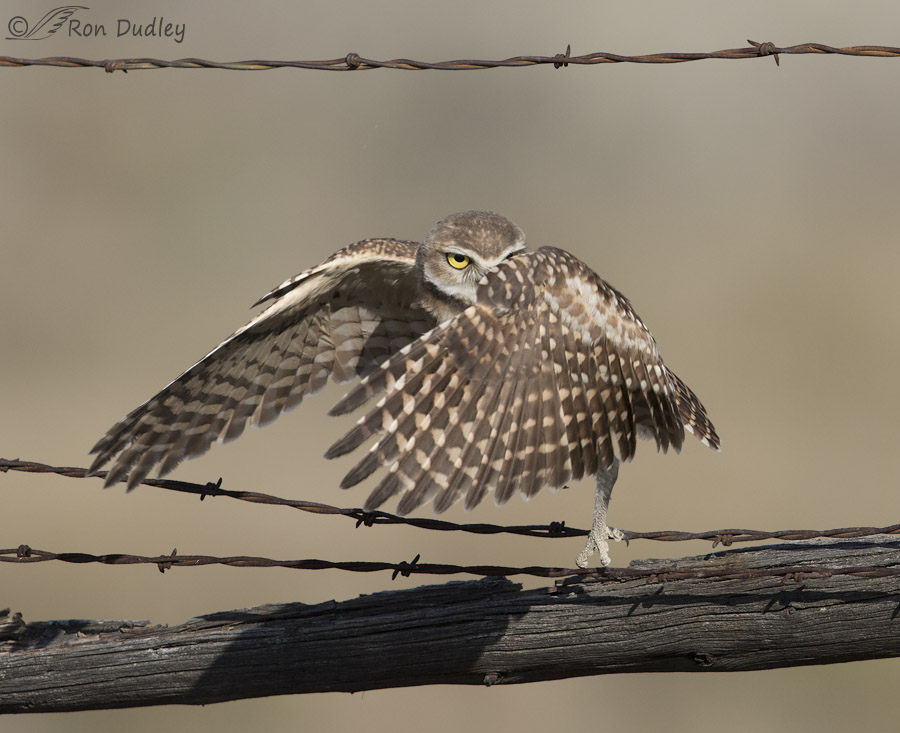
1/2500, f/6.3, ISO 500, Canon 7D Mark II, Canon EF500mm f/4L IS II USM +1.4 tc, not baited, set up or called in
In the next frame it gave me a peekaboo look as its foot left the wire…
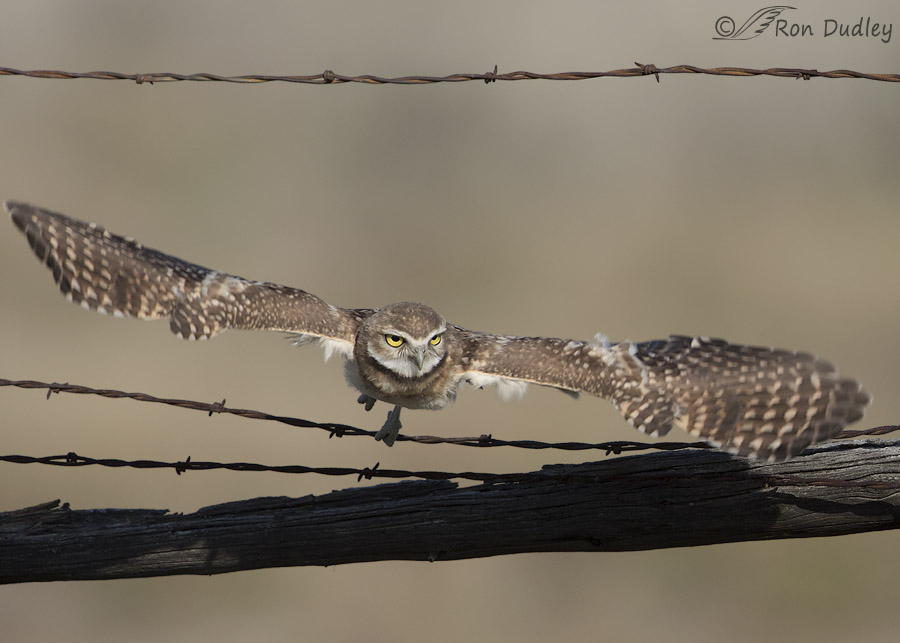
1/2500, f/6.3, ISO 500, Canon 7D Mark II, Canon EF500mm f/4L IS II USM +1.4 tc, not baited, set up or called in
and my next shot caught the wings fully extended. I wish I’d had just a tad more shutter speed (like I did in the first two images) to get the ends of the wings sharp but when the shadow of the extended wings darkened the fence rail it also slowed my SS from 1/3200 to 1/2500 sec since I shoot in aperture priority. This illustrates the reason why I try to have at least 1/3200 when I’m photographing these lightning-fast birds at take-off.
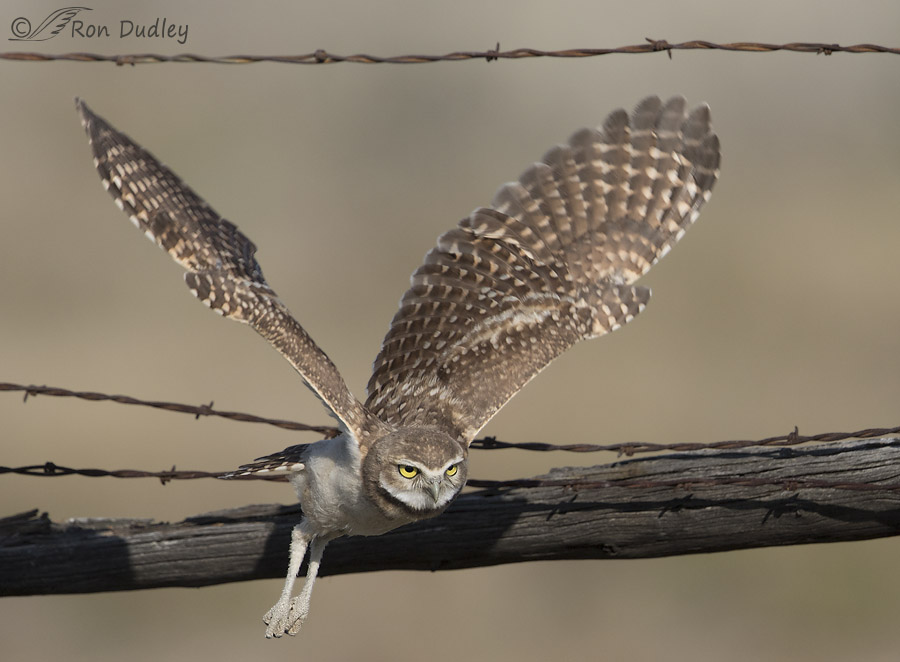
1/2500, f/6.3, ISO 500, Canon 7D Mark II, Canon EF500mm f/4L IS II USM +1.4 tc, not baited, set up or called in
I was pleasantly surprised to get one more shot where the face and body of the bird were sharp with it coming toward me. I wish I had little more room at bottom for a more pleasing composition but it just didn’t happen. At least I didn’t clip or cut off any body parts.
Now may I suggest that you go back and look more carefully at the second image in this series. You’ll notice that when this bird lifted off its right wing came in contact with the upper wire and at least one of its barbs. Anyone with experience with barbed wire knows that it can be nasty stuff and create havoc with animals that come in contact with it. Once it grabs a victim it usually requires a methodical and thoughtful process of extraction – something wildlife is incapable of. Struggling, the typical reaction of animals, just makes it worse. Much worse.
Thankfully this owl escaped the contact with the wire unscathed but not all of them do (the following two images are disturbing – fair warning).
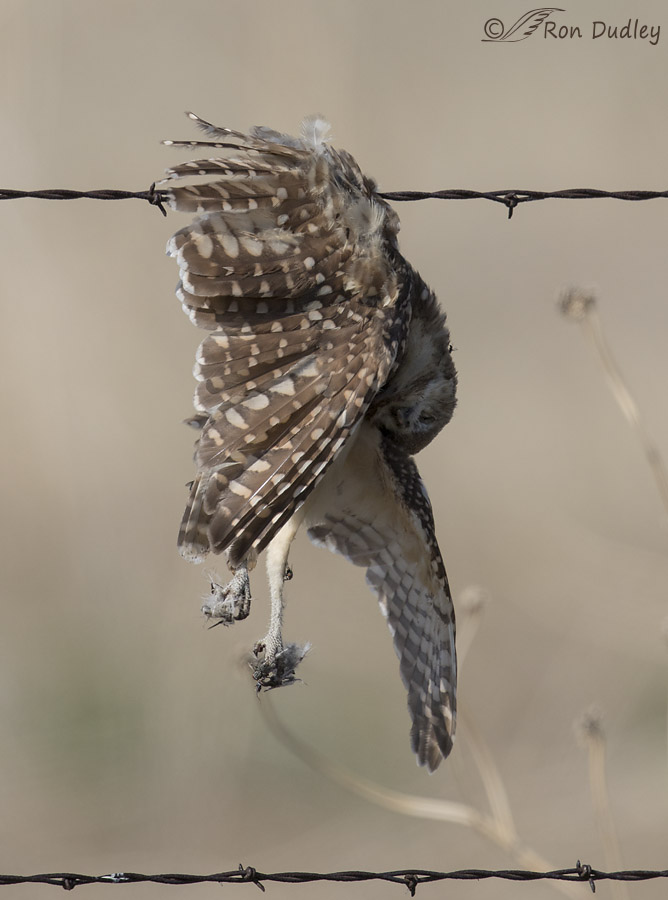
68 minutes after photographing the juvenile owl taking off we found another juvenile nearby that wasn’t so lucky. It was hanging from a strand of barbed wire and appeared to have died fairly recently. At the moment this area is teeming with juvenile Burrowing Owls who still have a lot to learn about the dangers of the world and I can’t help but wonder how many more will meet this same fate before they have time to wise up a little.
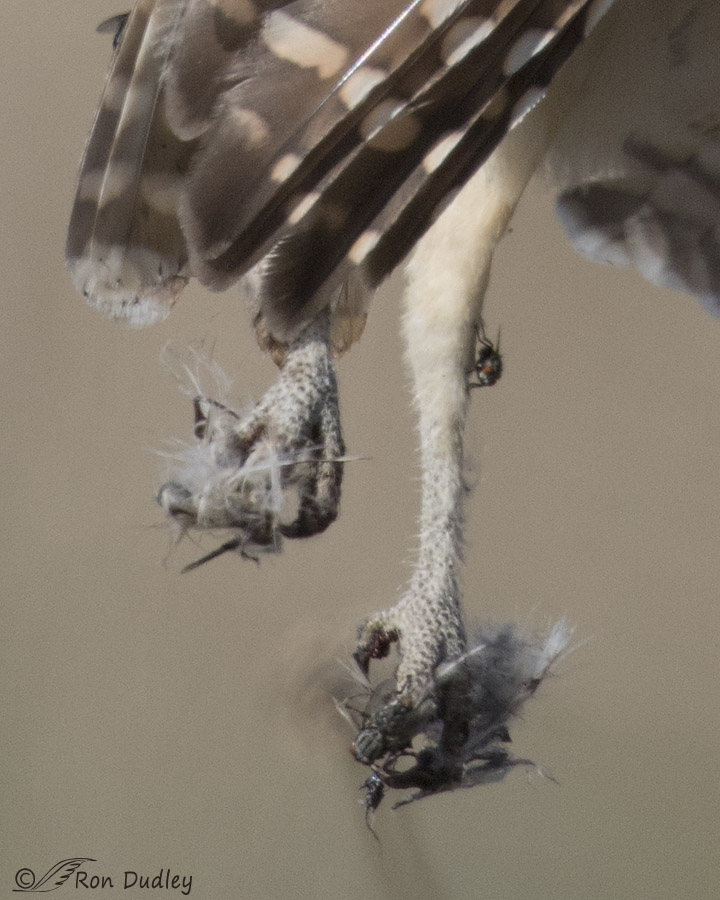
A large crop of the previous image reveals that the owl’s talons have what appears to be feathers sticking to them. I can only speculate about their origin but it’s my suspicion that the feathers belong to the owl itself – that they may have been scratched out of its own body during its death throes on the wire.
Mia reported this bird to authorities and they have committed to picking up the body. There are Greater Sage Grouse and several other species of upland game birds in this area but there are no tags or flags on the fences (that I’m aware of) that are often used to help Sage Grouse and other wildlife avoid the wires. I’m sure they’d help Burrowing Owls do the same thing and that step has already been suggested to authorities.
Sorry to end this post on a bummer but awareness is part of a potential solution so I went with it.
Ron


Our compliments, Mr. Dudley, for some spectacular photos of the “Burrowing Owls” and the exposure of the dire consequences of these birds when they contact Barbed Wire fences. Your comment on including the the Greater Sage Grouse is well researched ( Sage Grouse Initiative )as just one of many contributing factors to this species populations decline. With our FENCE-FLAGS® introduction to the marketplace over 20 years ago we continue to be informed of “species” we didn’t know even existed, that are prone to impact un-detected Wire Fences. Two recent examples are the “Hawaiian Petrel” and the “Great Bustard” of Portugal, both now listed as endangered. Our FENCE-FLAGS® do make a difference for VISIBILITY to avoid the IMPACT of an un-detected Wire barrier for those on wings, legs, ATVs, & Snowmobiles!. DJK
This broke my heart. Poor baby just starting out and his little life comes to an end. Is there a purpose to the barb wire? Can’t it be removed? It’s bad enough that man has taken so much of their territory and then they have to deal with this! He does look like he just took his last breath and it looks like he fought hard to get away. I love your owl photos so much but it will take a while to get this picture out of my head.
Beautiful. And tragic.
In equal measures.
Thanks, EC. Tragic indeed.
As much as I wish these images didn’t exist, it makes me want to get involved in helping somehow. Is there any way that I can? Letter writing?
Not that I’m aware of, Arwen. The Federal Agency this bird was reported to seems to be supportive of the owls and their predicament in this area and hopefully they’ll consider adding tags/markers to those fences. Good on ya for caring…
Too sick to comment…left my feelings on Mia’s site….
Fantastic series and a sad commentary.
Charlotte
Thank you, Charlotte.
Your Box Elder County Burrowing Owl photos are very special. I’ve enjoyed the series very much.
Thanks very much, Dave. Coming from you that means a lot.
It is heart-wrenching to see the shots of the dead baby, and I hope that Mia’s efforts for getting the wire marked will pay off. I love the last shot of the bird coming straight for you. The feather detail is spectacular, and I am struck by how huge the wings seem in comparison to the size of the bird’s body.
I hope so too, Susan. You mention the large wings of the species – that’s something that has impressed me too. It took me a long time to adjust how I shoot these birds because I kept underestimating how long they were and was continually cutting them off or clipping them at take-off.
So so sad!
It sure is, Ellen.
Hi Ron,
We have a similar issue here in Point Reyes National Seashore. The difference is, ours lies in abandoned barbed wire by those that maintain the fences. Barbed wire is too often simply discarded where it is removed from the fence. Elk and deer thrash their antlers in the barbed wire and it gets wrapped up in them. They typically have it there for the rest of the season until the antlers are shed. We actually lost an elk to starvation when the barbed wire cinched his jaw shut. I have many images of these struggling animals. It is truly sad.
Daniel
Barbed wire can be nasty stuff, Daniel. When a horse becomes tangled in it the results are often truly ghastly.